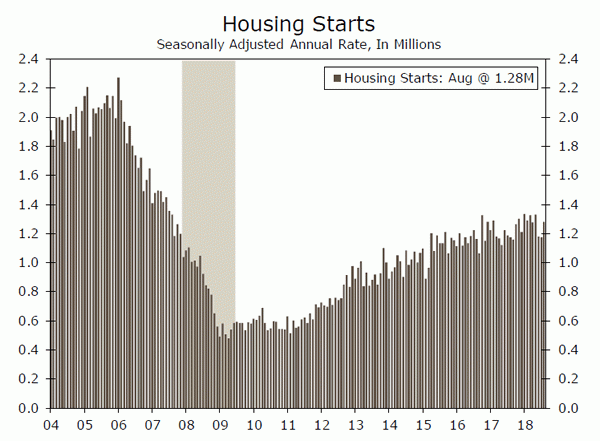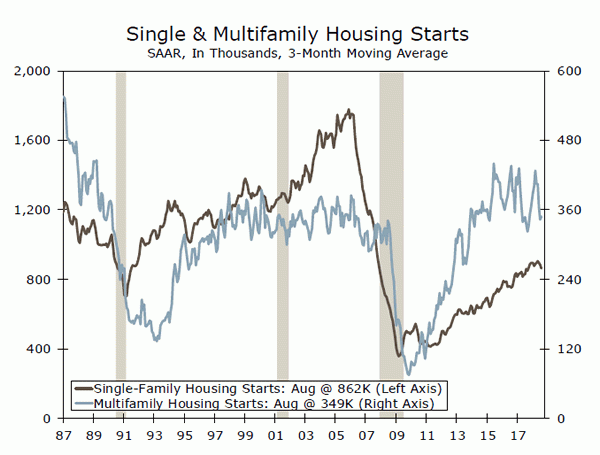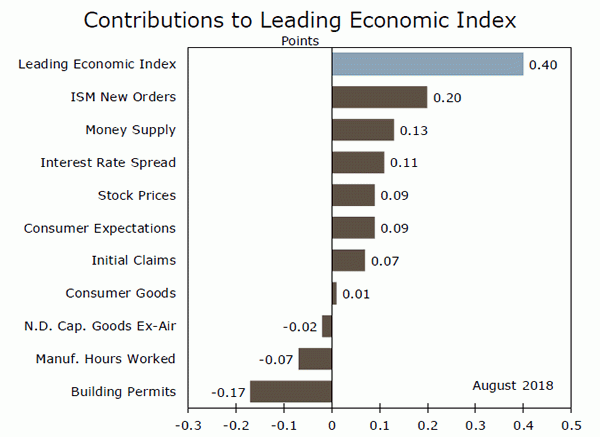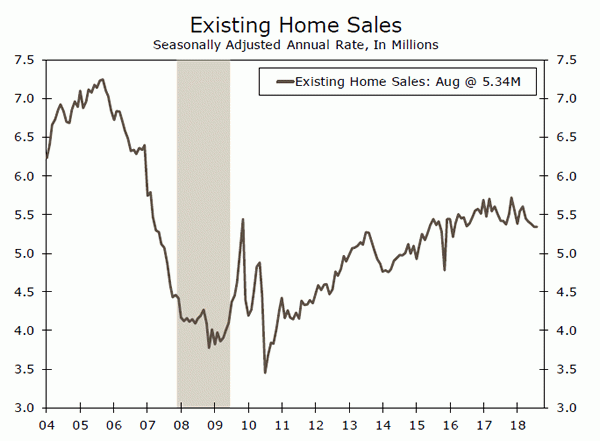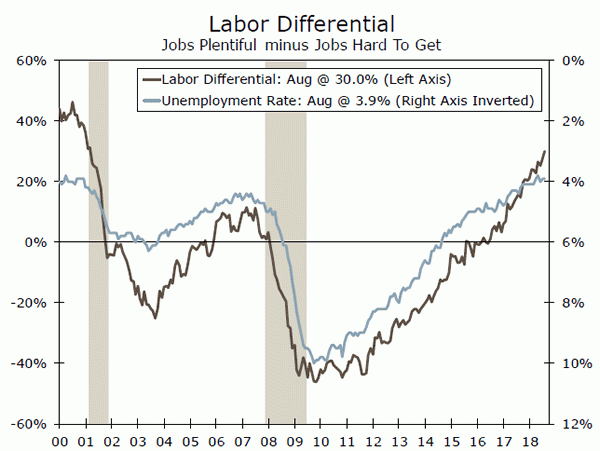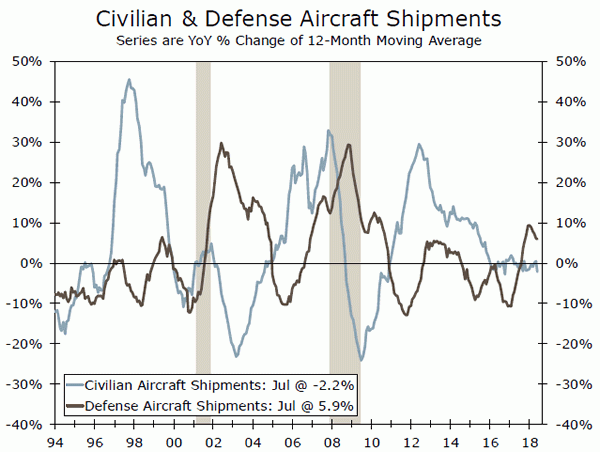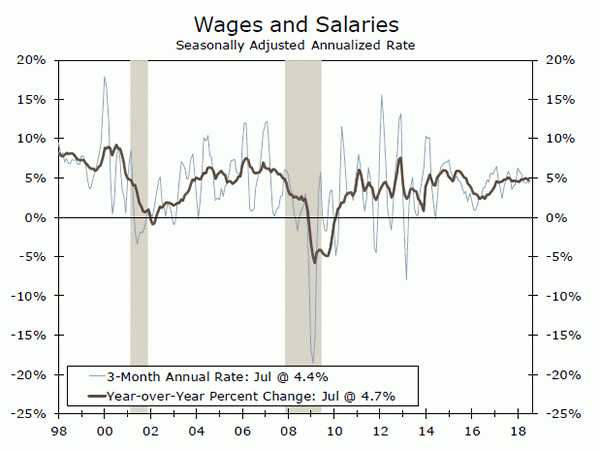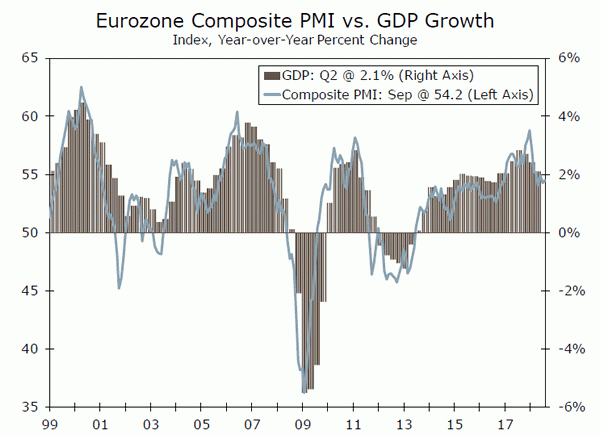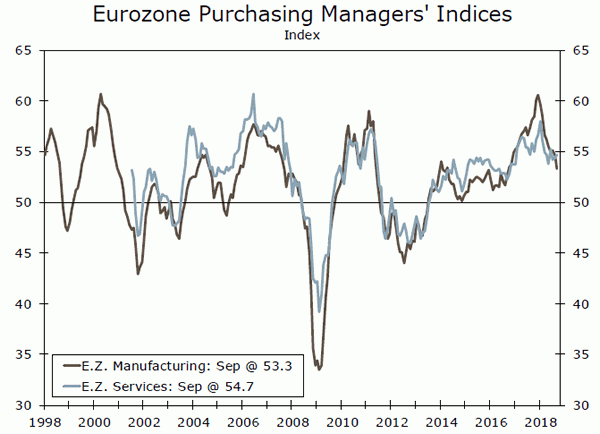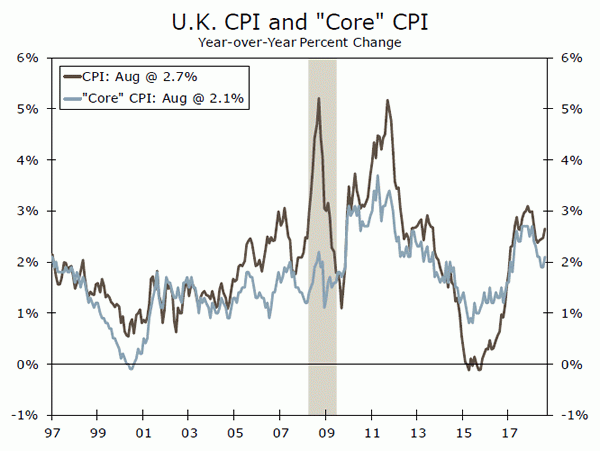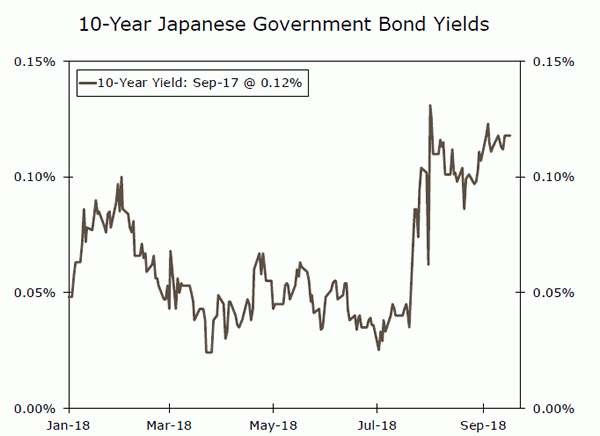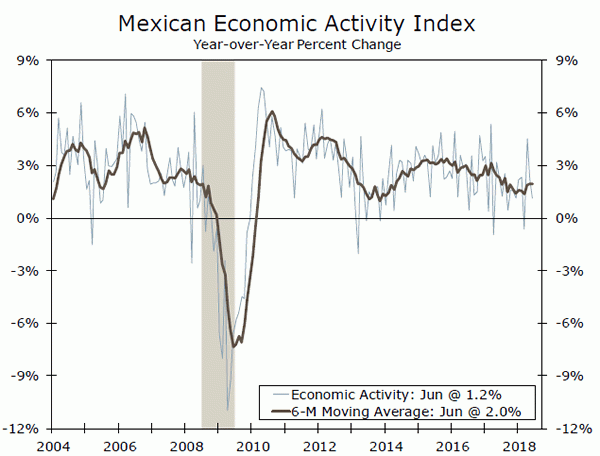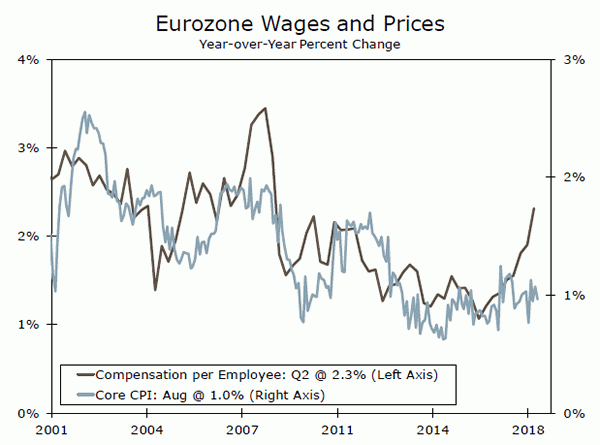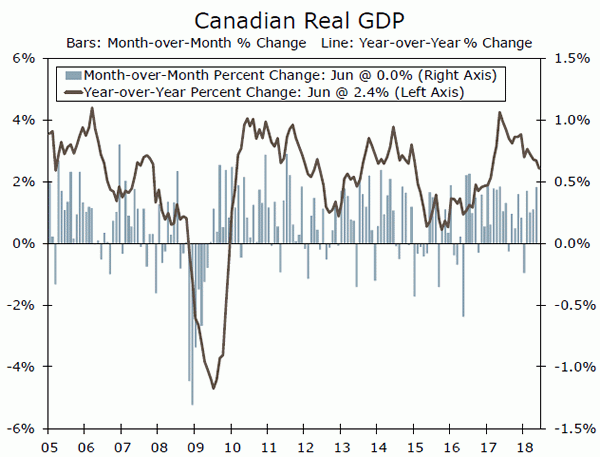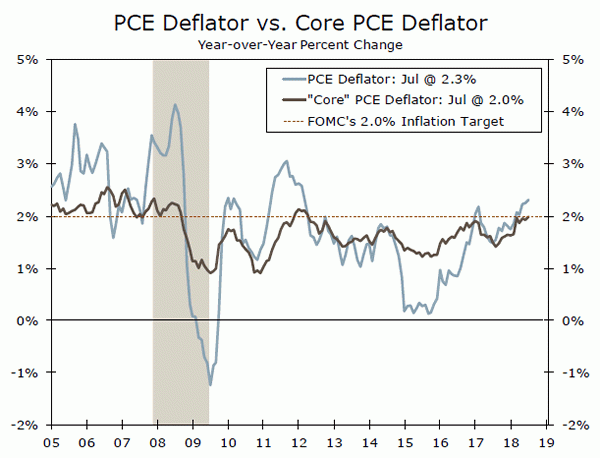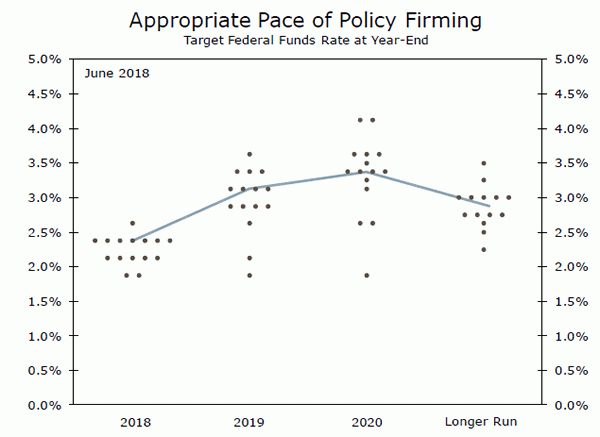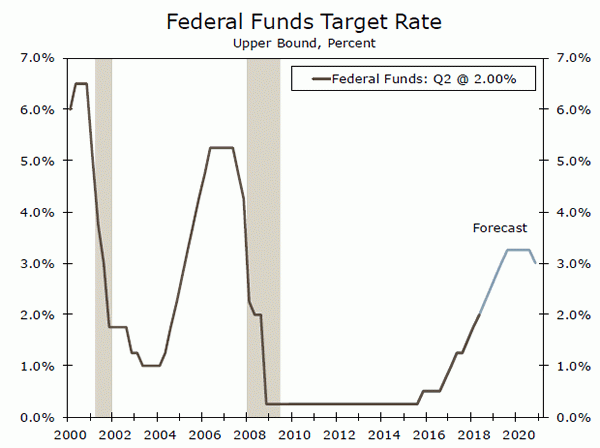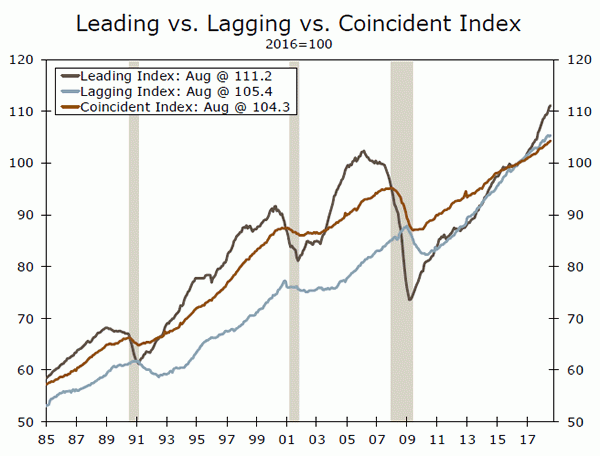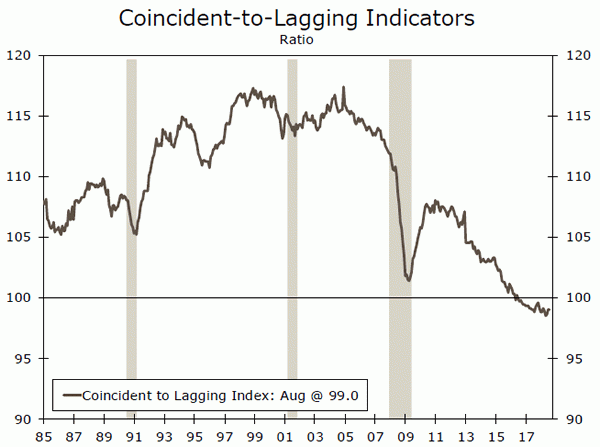U.S. Review
Housing Remains in a Soft Patch
- Housing starts rose 9.2% in August. Volatile multifamily starts increased 29.3%, while single-family units rose 1.9%. Building permits dropped 5.7% during the month.
- Existing home sales were unchanged at a 5.34-million unit annual pace in August. The total inventory of available homes was also unchanged at 1.92 million homes. The median price of an existing home rose 4.6% year-over-year.
- The Leading Economic Index climbed 0.4% in August, further evidence that economic growth should remain solid in the second half of 2018.
Housing Remains in a Soft Patch
The divide between the sluggish housing market and an economy that continues to exhibit signs of strength continued this week. Housing starts rebounded in August but building permits dropped. Home sales also came in below expectations, as resales of existing homes were unchanged. Despite housing remaining in a soft patch, we still expect real GDP to remain solid and grow 3.1% during Q3 and stay close to that pace through the remainder of the year.
Homebuilding remains subdued. Housing starts rose 9.2% in August; however, building permits dropped 5.7% during the month. Much of the improvement in starts arose from a 29.3% increase in multifamily units. Apartment construction is proving resilient, as affordability and supply concerns are preventing many renters from buying. Single-family starts rose 1.9%. Overall, housing starts came in above consensus, but that is not likely a sign that homebuilding will significantly pick up. Single-family and multifamily starts remain below the pace seen earlier this year.
Housing permits fell 5.7% in August, with multifamily declining 4.9% and single-family dropping 6.1%. Permits are now running below starts, suggesting homebuilding is losing a bit of steam.
The continued sluggish pace of homebuilding and decline in permits run counter to the still strong homebuilders’ survey. Shortages of lots and construction workers and higher material prices might be holding back some projects, particularly starter homes.
Home sales also continue to fall short of expectations. Sales of existing homes were unchanged in August at a 5.34 million unit annual pace, following four consecutive months of declining sales. The supply of affordable homes remains exceptionally lean. The total inventory of available homes was unchanged at 1.92 million homes, up from 1.87 million a year ago. Unsold inventory now equates to a 4.3-month supply at the current sales pace. The longterm norm for supply is around 5.5 months.
Existing home sales have been disappointing, as many homeowners remain reluctant to put their homes up for sale due to concerns that they will have a hard time finding a suitable home to buy. The lack of turnover in the housing market has contributed to the sustained run-up in home prices, as homes in desirable locations are tending to draw multiple bids and sell very quickly. The median price of an existing home rose 4.6% year-over-year to $264,800, up from 4.5% a month earlier. According to the National Association of Realtors (NAR), homes typically stayed on the market for 29 days, down from 30 days last August, with 52% of all homes on the market selling in less than a month.
Despite housing being stuck in the slow lane, broader economic activity appears to be solid. The Leading Economic Index (LEI) climbed 0.4% higher in August. The largest contributing factor was a 0.2 point gain from the ISM manufacturing new orders index. A majority of components were also positive contributors to the index, further evidence that economic growth should remain solid in H2-2018.
U.S. Outlook
Consumer Confidence • Tuesday
Consumer confidence jumped 5.5 points in August to 133.4. Consumers generally feel upbeat about current economic conditions, but are showing some concern about the future. Current optimism continues to be a reflection of the tightening labor market, as the share of consumers stating jobs as plentiful was little changed, and those who see jobs as hard-to-get fell 2.1 points. These dynamics pushed the labor differential up to its highest level since 2001. Expectations also rose in August, but the overall trend here continues to moderate and will be an area we continue to closely monitor. Consumers generally expect incomes to rise over the next six months, while employment conditions are expected to remain fairly stable. The proportion of consumers who believe present business conditions are good reached a cycle high of 40.3 in August; however, those expecting conditions to worsen rose to 10.5, the highest level since February 2017.
Previous: 133.4 Wells Fargo: 130.5 Consensus: 132.0
Durable Goods • Thursday
Durable goods orders at U.S. manufactures fell 1.7% in July. The drop was larger than expected, but can mostly be tied to the more than 34% drop in civilian and military aircraft orders. Aircraft shipments remained in line with recent trends. Stripping away the aircraft component, there was fairly broad-based strength in the durable goods report. However, we will be paying close attention to any bounce-back in nondefense shipments in the August report this Thursday, given the BEA includes aircraft in its initial estimate of equipment spending for GDP. Another area that will garner our attention in the upcoming release is inventories. Inventories jumped 1.3% in July, which was the largest one-month stockpiling since 2011. Coming on the heels of a $26.9 billion drawdown in Q2 inventories, even a modest increase in Q3 could add a full percentage point to headline GDP. We expect to see some rebound in August with durable goods orders rising 1.1%.
Previous: -1.7% Wells Fargo: 1.1% Consensus: 1.8% (Month-over-Month)
Personal Income & Spending • Friday
Personal income rose 0.3% in July. Strong job growth and a tight labor market continue to be reflected in the sustained pace of wages and salaries, which were up 4.7% on a year-over-year basis. Personal spending remained elevated, rising 0.4% for the second consecutive month. Consumer spending grew at a break-neck pace in the second quarter, and July’s increase in spending offers some affirmation that strong consumption carried into the current quarter. Modest gains in income and rising inflation, however, suggest the pace of spending may slow somewhat in the second half of the year. The overall PCE deflator rose 0.1% in July, this nudged the year-over-year rate up to 2.3%, marking the fastest pace in six years. Core PCE, a more reliable gauge of underlying inflation trends, was up 2.0% from a year-ago in July. With both figures in line with the Fed’s target, there was nothing in July’s report to dissuade policy makers from another rate hike at next week’s monetary policy meeting.
Previous: 0.3% & 0.4% Wells Fargo: 0.4% & 0.3% Consensus: 0.4% & 0.3% (Month-over-Month)
Global Review
Firmer Global Growth to Be a Gradual Process
- This week’s global data were mixed. The Eurozone services PMI rose in September but the manufacturing PMI fell, while in the U.K., August CPI inflation and retail sales were both firmer over the month. Signs of global growth improvement remain gradual, and we still look for ECB and Bank of England policy rates to remain steady for some time.
- This week saw some central bank monetary policy announcements, but limited action. Norway’s central bank hiked interest rates in response to firmer growth and inflation. The Swiss central bank kept interest rates in negative territory, while the Bank of Japan held monetary policy unchanged.
European Data Mixed, Central Banks Mostly Steady
This week saw several economic releases from Europe which were mixed overall and do not yet represent a strong upswing. From the Eurozone, this week’s key releases were the manufacturing and service sector purchasing managers indices (PMIs) for September. The manufacturing PMI fell to 53.3, and is now at its lowest level since late 2016. However, the PMI for the service sector–which accounts for the majority of the Eurozone economy–rose to 54.7. Overall, confidence surveys remain consistent with GDP growth in the 1.5%-2.0% range. While there have been some hints of firming wages across the Eurozone, underlying inflation pressures are muted and likely to pick up only gradually, meaning that European Central Bank interest rates should be on hold for an extended period.
In the United Kingdom, economic data were a touch stronger over the past week. August CPI inflation firmed to 2.7% year-over-year, and core CPI inflation firmed to 2.1%. Despite that uptick, inflation pressures are dissipating overall, after a post-Brexit inflation surge as the pound fell sharply. Meanwhile, August retail sales unexpectedly rose 0.3% month over month, and the July sales gain was revised higher. Still, coming after relatively moderate Q2 GDP growth of 0.4% quarter over quarter (not annualized), we do not see growth or inflation as strong enough to draw the Bank of England off the monetary policy sidelines at this point, especially given the potential for uncertainty to persist while U.K. and European officials continue to negotiate the terms of the United Kingdom’s post-Brexit relationship with the European Union.
There were also a couple of central bank monetary policy announcements of note in recent days. Norway’s central bank raised its deposit rate by 25 bps to 0.75%, as CPI inflation and economic growth have firmed perceptibly in recent months and quarters. Norway’s central bank also indicated that further rate increases were likely, but at a slightly slower pace than previously signaled, with the deposit rate projected just above 2.00% by the end of 2021. In Switzerland, even with solid growth and some quickening of inflation, the Swiss National Bank kept its policy interest rate deeply in negative territory at -0.75%, and gave some hints of concern about Swiss franc strength, stating the currency had appreciated noticeably.
Bank of Japan Keeps Monetary Policy Unchanged
Japan’s central bank made no change to its monetary policy stance at its September meeting. The “on-hold” outcome is not surprising given that at its most recent meeting in July, the central bank kept its target for the 10-year government bond yield at zero percent, but doubled the tolerance band for variability around that target to +/- 20 bps. Q2 GDP growth was solid enough at 3.0% annualized, and the August CPI excluding fresh food firmed to 0.9% year over year. That remains well short of the Bank of Japan’s inflation goal of 2% and, moreover, price gains have mainly been led by higher food and energy prices. We do not expect the central bank to adjust policy further for the time being.
Global Outlook
Mexico Economic Activity • Tuesday
Mexico’s economy has endured a great deal of uncertainty this year, with ongoing NAFTA negotiations and a pivotal presidential election among the key economic events of focus in 2018. Despite that uncertainty, the Mexican economy has been resilient, and in fact, growth is showing signs of picking up. Indeed, economic activity has accelerated modestly in recent months after a lengthy slowdown, supported by a rebound in the manufacturing and construction sectors. Strong U.S. economic growth and a competitive exchange rate have likely helped activity in these sectors at the margin.
Meanwhile, growth in the services sector has remained subdued. In all, high real interest rates are likely to limit the extent of any pickup in overall economic growth in Mexico, even as solid U.S. growth provides ongoing support for the Mexican economy. Our forecasts call for GDP growth in Mexico of just 2.2% in full-year 2018.
Previous: 1.15% Consensus: 2.60% (Year-over-Year)
Eurozone Core CPI • Friday
Inflation remains the key variable of focus for the European Central Bank (ECB) as it moves toward a less accommodative monetary policy stance. With core inflation “stuck” near 1%, there is little urgency for the central bank to further dial back easy monetary policy, for now. That lack of urgency is reflected in forward guidance from the ECB, as it said that interest rates would likely remain on hold at least through summer 2019.
That said, underlying inflation pressures in the Eurozone are firming, a sign that a pickup in core inflation may not be too far off. Indeed, as the region’s labor market has tightened, wage growth has climbed in recent quarters. In our view, it will be particularly important to monitor the pass-through from quicker wage growth to core inflation for signs on whether the ECB will need to rethink its current guidance on interest rate policy.
Previous: 1.0% Consensus: 1.1% (Year-over-Year)
Canada GDP • Friday
Economic growth in Canada has softened a bit in recent months after a strong 2017, in which real GDP rose 3% during the year. The slowdown has been relatively broad based, although to be sure, GDP growth in Canada remains above the Bank of Canada’s (BoC) estimate for potential growth. Indeed, real GDP rose 2.4% year over year in June, compared to the BoC estimate for potential growth of just below 2%.
Based on these estimates, the output gap (the gap between actual and potential GDP) in Canada is likely continuing to narrow, a dynamic that is consistent with core inflation right around the central bank’s 2% target. While growth could edge lower in the months ahead, the BoC likely will push on with its gradual rate hike cycle. We look for one more 25 bps rate hike from the BoC before year-end as long as inflation remains firm.
Previous: 0.0% (Month-over-Month)
Point of View
Interest Rate Watch
FOMC Meeting More About 2019
The FOMC is all but certain to take the fed funds rate up another 25 bps at next week’s meeting. Currently the market places the chance of a quarter-point hike at 98%. That will make any communication tweaks about future rate hikes the main draw on Wednesday.
There are likely to be few changes to the post meeting statement. Recent indicators point to growth remaining “strong.” Risks still look to be balanced as the Fed navigates the tailwinds of fiscal stimulus with the potential headwinds of trade dislocations and volatility in emerging markets.
While the statement is unlikely to provide much new insight, updated economic projections should help bring the near-term rate path into view. In June, the median estimate for the fed funds rate at year-end rose to 2.4%, implying another rate hike in December. With hiring still robust and core PCE inflation reaching the Fed’s 2% target for the first time in six years, we would expect the “dots” to show that the majority of FOMC members still support a total of four rate increases this year.
More uncertainty surrounds 2019. The additional two rate hikes before the end of the year would bring the fed funds rate to 2.25%-2.50%, only about 50 bps below what most Fed officials estimate to be “neutral”.
At its June meeting, the committee indicated it would likely be appropriate to raise rates above their long-run level by 2019 or 2020, consistent with the median estimate for three rate hikes in 2019. We are in the camp that the FOMC will carry on raising the fed funds rate 25 bps points once a quarter through Q3-2019. At that point, the fed funds rate is likely to be slightly restrictive based on FOMC estimates. Markets, however, are more skeptical. Futures point to the fed funds rate rising to about 2.75% by next September.
The timing and degree of policy changes next year come with an added degree of uncertainty as we reach a critical stage of the cycle. Not only are there questions about neutral, but press conferences after each meeting and new members, including Vice Chair Rich Clarida this month, may also sway the timing and path of policy changes.
Credit Market Insights
The Changing FOMC Composition
This week brought several announcements related to the FOMC. First, Mary Daly was appointed as the head of the San Francisco Fed effective on October 1, meaning she will be a voting member of the FOMC beginning with its November meeting. Next, Richard Clarida was sworn in as Vice Chair; he will vote at the FOMC meeting next Wednesday. Lastly, the White House announced the nomination of Nellie Lang to the Board of Governors, pending Senate confirmation.
While the Senate is otherwise consumed with a rather more contentious confirmation process, Lang will join Marvin Goodfriend and Michelle Bowman in the queue of appointed Fed Governors awaiting confirmation. While such a shift in composition could have implications for the future path of the Fed’s interest rate-setting body, we do not expect a major change in course in the near term. The FOMC, under the leadership of Chair Powell, will continue to operate under a “risk management” framework—one that is largely continuous with former Chair Yellen’s data dependent “wait and see” approach. Indeed, our call for two more rate hikes this year is largely in line with market-implied probabilities and the FOMC’s own projections. But, as mentioned in Interest Rate Watch, monetary policy in 2019 is more uncertain. We see three hikes next year, but as views begin to diverge about the prudent path of the fed funds rate, it will become more important and informative to know the names, faces and views behind the dots.
Topic of the Week
More than Just a Coincidence?
We learned this week that the Leading Economic Index (LEI) was up again in August. Maybe you missed it. It did not exactly cause a halt in trading when it hit the wire. Maybe that’s because the LEI has not posted a sequential decline in 27 months. Business cycle indicators have a tendency to fade into the background as a sense of complacency inevitably sets in when the economy is booming and the stock market is setting record highs. Is there anything that market-watchers might be missing in the underlying details?
The release of the LEI also brings with it fresh readings on two other business cycle composites, the Coincident Index and Lagging Index. As the names imply, these measures offer a contemporaneous assessment as well as a rearview mirror for testing the winds of the economy. All three are plotted in the top graph and a few interesting things emerge. First, the good news: the LEI is rising at a steep incline signaling fair skies and following seas. Although we also would point out that, interestingly, the lagging index (blue line) is outpacing the coincident index (maroon line) and this recent emergence in this cycle is the first time that this has happened in the past 30+ years.
There are some advocates of another approach and that is to make a ratio of Coincident-to-Lagging indicators. We have plotted this ratio in the lower chart. A theory popularized by the economist Richard Yamarone is that when an economic expansion is peaking, both measures are rising but the rate of increase for the coincident measure will be smaller and will thus result in a decline in the coincident-to-lagging ratio.
You might take a skeptic’s view of the warning in this cycle as the coincident-to-lagging ratio has declined on trend since about 2013. Still, as the current expansion nears the end of its 111th month, this is no time for complacency. We still think the expansion has a few years to run, but we’ll use this space to keep you updated on warning signs along the way in the months ahead.




